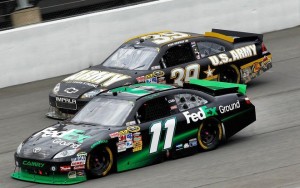It’s time for NASCAR to improve the racing at Michigan International Speedway.
The speedway has seen numerous improvements over the years, mostly to better the fan experience outside the track itself, but Sunday’s Heluva Good! Sour Cream Dips 400 illustrates that the series needs to improve racing at the 2.0-mile tri-oval in the Irish Hills.
One of the main reasons for NASCAR’s explosive growth in recent years has been the competitiveness of the racing. Tradin’ paint, jockeying for position and liberal use of yellow lights and almost identical cars – all make the series the most competitive form of automotive racing in the world.
However, Sunday’s race at Michigan’s 42-year-old track was a snooze. Denny Hamlin led 123 laps out of 200. Only two other drivers, Kurt Busch and Kasey Kahne, were anywhere near him for most of the race.
Race winner Denny Hamlin said it appeared to him that NASCAR did its best to bunch up the cars, calling what appeared to be a phantom caution for debris on the track with 17 laps to go, for one final restart.
Kasey Kahne, 9 seconds behind, said he saw debris, not without self interest.
“I knew a caution was coming, so I might as well back off and save my tires,” Hamlin said. “I knew that debris caution was coming. We’ve got to do what’s right for the fans, and they need to see a great race at the end. The best car won — and that’s all you can ask for.”
As is typical at Michigan, the race followed a familiar formula: Long green-flag runs resulting in the field being strung out, mostly single file, until a rare caution brings out the yellow flag. The yellow allows the followers to catch up with the leaders, at least temporarily, until the field stretches out again. With just three cautions, there was very little change in track position for the drivers during the entire race.
Many non-NASCAR fans derisively say that anyone can drive in circles. They don’t understand the nuance to the sport. But races at Michigan make it hard to defend. Typically, unless the race turns into a battle over fuel economy, such as the June 2009 race, there is little tension or excitement as the cars close in on the checkered flag.
The best racing is when the cars are evenly matched and tightly bunched together and the drivers must draft off of each other to maintain speed. At MIS, drafting doesn’t seem to be as important. Cars run better there in “clean air,” unaffected by the other cars.
NASCAR racing is more fun to watch at other tracks such as short tracks at Martinsville and Bristol or even the Daytona and Talladega restrictor plate tracks. Lead changes are frequent and the race winner is often in doubt until the cars come around the final turn. Such races at MIS are rare.
So what’s the answer? There might not be a good one. The track doesn’t allow the cars to generate the excessive speed that made restrictor plates – a plate between the carburetor and intake manifold which restricts the amount of air entering the engine – necessary at other tracks. And the track, owned by a subsidiary of NASCAR, is not about to reconfigure the track itself to improve racing. But someone at NASCAR should be looking at the problem.

